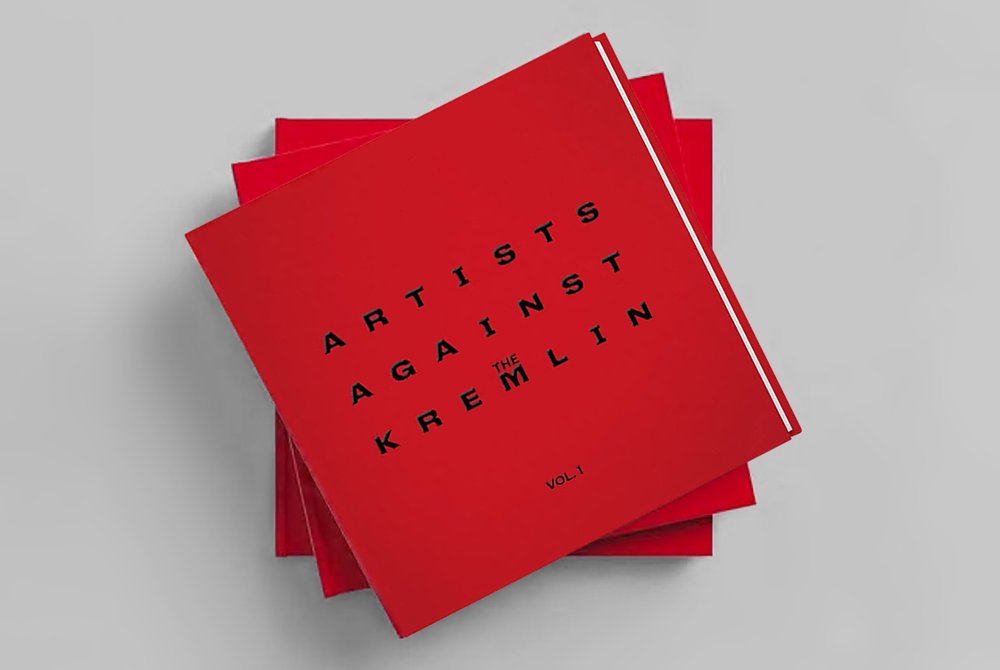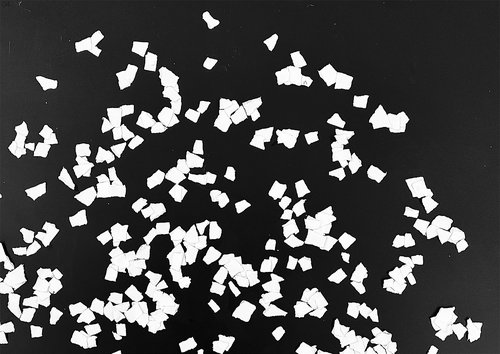A Controversial Encyclopaedia of Protest Art

Artists against the Kremlin, vol. 1. 2025. Book cover. Courtesy of The Moscow Times and All Rights Reversed Gallery
Art critic and curator Alistair Hicks reviews a multi-tasking book for a brave ongoing protest campaign which has already produced nearly a dozen exhibitions throughout Europe. It does not just catalogue art but is full of interviews. Many of the artists have already paid for their resistance with time spent behind bars. Two of the artists are from Ukraine, showing a rare, united front of protest.
Very few people will like this review. A small percentage of the art shown in the book called ‘Artists against the Kremlin, Volume 1’ hits the mark. A slightly larger fraction effectively rings the protest bell. Yet the artists and the curators are brave. I too would like to bury Caesar rather than praise him, but as the response to my last review established that is not the role of the ‘endlessly ignorant outsider.’ Let’s dwell instead on the art that rings loudest.
It is good to report that the most effective art in the book is the subtlest. There are two threads – a strange Russian twist to the Duchampian legacy and a studied innocence. Sometimes, almost miraculously, they interweave.
The book is laid out simply with ‘curators’ notes’ for each illustration. The curators explain the apparent innocence in the artist’s work by writing: ‘In an authoritarian state, society is often kept in a prolonged state of enforced infantilisation’. This is most clearly illustrated by Daria Apakhonchich (b. 1985), the first artist to be designated a ‘foreign agent’ in Russia. Her ‘Report for the Ministry of Justice (for the third quarter of 2024)’, at first sight looks peaceful and elegant. Three pages are taken up with black and white drawings that have the simplicity of linocuts. They are drawn on top of the actual official typed forms that she was obliged to answer. This one reads:
‘Hello, Ministry of Justice
Four times a year, you expect reports from me detailing
What I have been doing over the past three months.
I walked through the mountains, the same ones that
People traverse to escape the war.
I swam in the Black Sea, which was warm and calm.,
But I knew that mines were exploding off the Ukrainian coast.
I saw flowers that grew during the war.
And it was both beautiful and terrifying.’
The toy train Alenky Tzvetochek paints naively also hints at the sad desire to leave and migrate. Flames are painted licking up the side of the engine, which the artist is driving as though still a child. The steam spiralling from the funnel is black and looks ominously like a barbed wire defence against any movement to and/or away from the Soviet housing estate. The curators’ notes do a good job: here they suggest the artist was under the influence of a famous exile, Boris Grebenschnikov’s (declared a foreign agent by the Russian authorities) 1988 song ´This Train is on Fire´. I google and find his music video for the song. He is sitting on a train strumming on his guitar as the old steam engine hurtles through a snowy, collapsing Soviet Union. There are fiddlers sitting on the speeding roof bowing frantically away while Russia, not Rome, burns. And the great Boris is singing:
This was our land when we left,
Trapped in endless and pointless war—
It will die unless we return
And reclaim our land once more.
I am still alive, but I made the mistake when talking of Boris to a Russian friend of bringing up the name of the Arkansas boy Johnny Cash. Fulsom Prison Blues mentions a train, but apparently Cash is more ‘Country’ and has a completely different baritone to the St. Petersburg cult rebel. Bob Dylan with his obscure lyrics, was closer to the mark. I did not dare ask the next question I had prepared for my friend: whether Alenky Tzvetochek was a false name based on the Russian fairy tale the Scarlet Flower. I did not want to admit that I was dancing off down another tangent identifying with the swashbuckling hero of Baroness Orczy’s Scarlet Pimpernel.
Faux-innocence is also a tool of Liza Pushkina. Dacha 1 (2024), is a self-portrait of her as a young child with a little curl in her blonde hair. It is part of a series of works painted on lace, which she says are ‘evoking memories of my childhood home.’ She explains how the blurriness shows ‘how memories fade over time.’
With the group ARTISTERROR, Pushkina has also made another work published in the book which leans towards the way Duchamp used found objects. Shch-856 (2023), is a modified Oscar statuette. The Golden figure is wearing a black prison jacket with the number Shch-855, one number higher than that of Solzhnenitsyn’s Ivan Denisovich. The rising number emphasises the increasing numbers of political prisons. There is also a direct reference to the documentary about Prisoner Number One, Alexey Navalny, which won an Oscar.
ARTISTERROR’S Mission Impossible (2022), uses parts of a bicycle in a fashion far removed from Picasso’s bull horns handlebars. It rather dwells on how one can turn a simple efficient system into a static pile of junk.
Before we conclude with the most haunting vision, it must be stated that there are many artists in this book whose work has been given greater poignancy by the Russian State. Locking up Nadya Tolokonnikova (b. 1989) (declared a foreign agent by the Russian authorities) and Maria Alekhina (b. 1989) has made Pussy Riot’s work look far more powerful. All Pavel Krisevich (b. 2000) has to do to gain an Ai Weiwei (b. 1957) glow is to use bed sheets from his Russian prison. Even though illustration for books has a very special place in Russian art history Sasha Shochilenko (b. 1990), would not have caught international attention if she had not been condemned to jail for seven years. The injustice to her makes her Peaceful Criminals (2024) glow like the saints in ancient icons.
Alexei Balabanov’s (1959–2013) 2007 film Military Cargo 200, set in a Soviet province in 1984 during one of the many Afghanistan wars, tells the story of the kidnapping and rape of a Party Official’s daughter. SLAVA PTRK (b. 1990) (declared a foreign agent by the Russian authorities) have made a funfair cardboard cutout with two empty face holes for anyone who comes along, to show how random persecution can be.
We conclude with some found objects, transformed by two artists. The first is not in this book as it is made by the Turkish artist Hale Tenger (b. 1960), but it is aimed straight at the same regime. It shows a pair of Russian nutcrackers. In its jaw it has a toy globe. It was made seven years before the present regime came to power but accurately mirrors how the Russian nutcracker saw himself. It was entitled: World Cracker (1992). The other object is a simple cheese grater, but an artist who calls himself BMTH has turned it into a Soviet-style panel apartment building, known ‘affectionally’ as Khrushchyovka. They know how to grind you down.
Artists against the Kremlin, vol. 1. 2025.
Artists against the Kremlin, vol. 1. 2025.
The Moscow Times & All Rights Reversed gallery
Amsterdam, the Netherlands
















